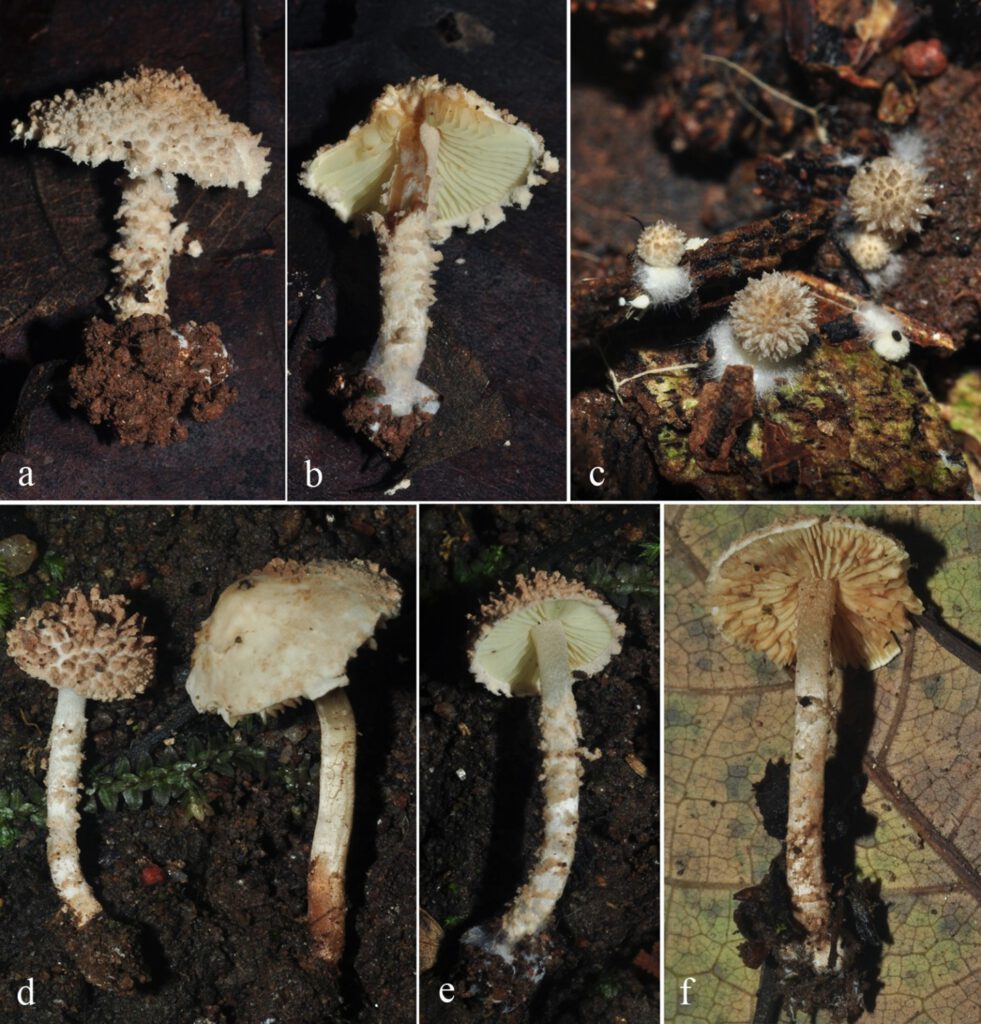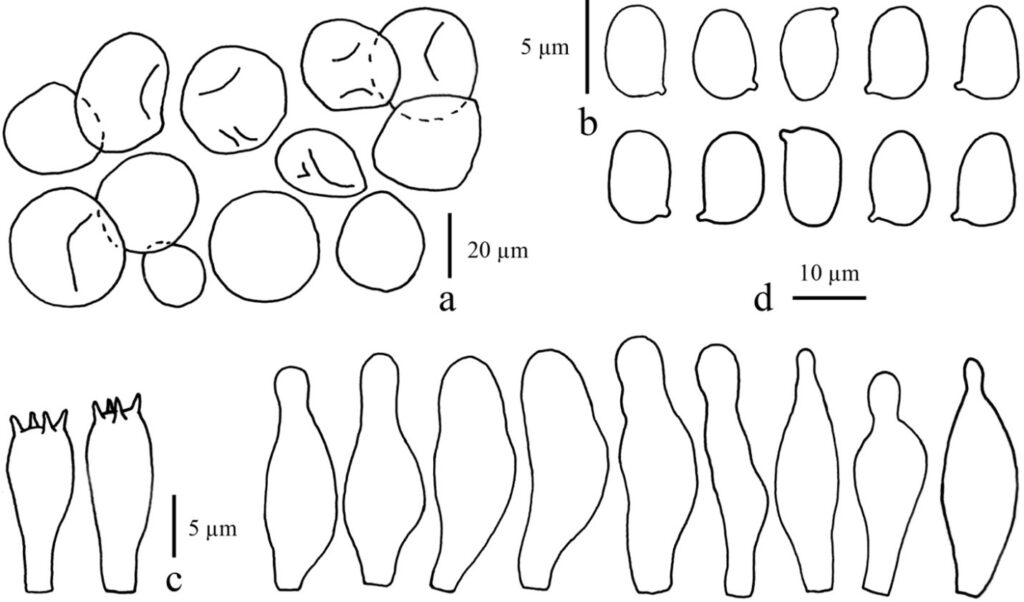Cystolepiota pyramidalis
MycoBank number: MB; Index Fungorum number: IF; Facesoffungi number: FoF 10598;
Description
Pileus 15–45 mm diam., first parabolic or campanulate, expanding to convex or umbonate, with straight margin, when young completely covered with crowded pyramidal or irregular pyramidal squamules, brownish (6D7–8), soon breaking up into brownish (6D7–8) to light brown (6D4-5) pyramidal to granular pyramidal squamules or warts toward margin, sparse or fragile when mature, on orange white to pale orange (5A2–3) background; margin covered with concolorous pyramidal to granular pyramidal velar remnants. Lamellae free, 3–5 mm wide, pale yellow to pastel yellow (3A3-4), becoming brownish orange (6C4–6) when touched or mature, broadly ventricose, with 3–4 lamellulae, with concolorous smooth to slightly eroded edge. Stipe 25–40 × 4–5.5 mm, cylindrical, covered with concolorous squamules to those on pileus, sparse at apex, fragile when mature, on orange white to pale orange (5A2–3) background. Annulus an annular zone, with velar remnants and concolorous to pileus margin, sometimes fragile with age. Context white in pileus, up to 1 mm thick at center; hollow in stipe and concolorous with surface. Odor and taste not observed. Spore pint white.
Basidiospores [50,2,2] 3.8–4.5 × 2.5–3.2 µm, avl × avw = 4.1 × 3.0 µm , Q= 1.25–1.6, avQ = 1.37, ellipsoid-ovoid in frontal view, ellipsoid in side-view, slightly thick-walled, smooth, hyaline, non-dextrinoid, non-amyloid, cyanophilous. Basidia 15–18 × 4.5–7 µm, clavate, thin-walled, hyaline, 4-spored, sometimes 2-spored. Lamella edge sterile [is that correct?]. Cheilocystidia 20–40 × 7–15 µm, variable in shape, irregular cylindrical, fusiform, narrowly utriform to utriform, lageniform, clavate with excrescence at apex, slightly thick-walled, hyaline. Pleurocystidia absent. Pileus covering an irregular epithelium composed of globose to subglobose elements, 35–65 µm in diam., slightly thick-walled, smooth, with pale brown to brown parietal and intracellular pigments. Stipe covering an irregular epithelium same as on pileus. Clamp-connections present.
Habitat and distribution – growing in small groups, saprotrophic on humus-rich soil of mixed deciduous forest with Castanopsis spp. and Lithocarpus spp. dominant; the species is rare; and so far, known from Oudomxay province, northern Laos, and Chiang Rai province, northern Thailand.
Additional material examined – Laos, Oudomxay Province, Xay District, Houay Houm Village, 18 August 2014, P. Sysouphanthong, PS2014-8290 (HNL502500, holotype); Thailand, Chiang Rai Province, Muang District, Phoo Kham Fah village, 15 Aug. 2012, P. Sysouphanthong, PS2012-11 (MFLU12-1774, paratype).
GenBank numbers: ITS: MZ574554, MZ574555 (ITS1-F/ITS4).
Notes – Cystolepiota pyramidalis is rare in Laos and Thailand; it was found in two locations, not far apart from each other at similar elevation, viz., Oudomxay Province of north Laos and Chiang Rai Province of north Thailand. The specimens from these two locations are identical both in morphological and in molecular characters. It is distinguished by light brown to brown pyramidal squamules on basidiomata and pale yellow to pastel yellow lamellae. This new species is distinguished from other species by yellow lamellae and the distinct pyramidal shape of squamules on pileus.
Cystolepiota pyramidalis belongs to a clade of similar species (fig. 1); C. fumosifolia, known from North America and Europe (as C. cystidiosa, C. luteicystidiata, and L. lycoperdoides), also has pyramidal granular warts on the pileus, but the cheilocystidia and abundant pleurocystidia have yellow contents, and the cheilcoystidia are covered with yellow exudate; C. pseudofumosifolia from China has white lamellae, and lacks the pyramidal warts on the cap, it also lacks pleurocystidia.
There are some other species with yellow lamellae in the genus. Firstly, Cystolepiota bucknallii (Berk. & Broome) Singer & Clémençon, known from temperate regions in Europe and North America has pale yellow to pastel yellow lamellae, but the pileus and stipe are covered with lilac granulose squamules, and the much longer (7–9 µm) spores are dextrinoid (Vellinga, 2007; Vellinga & Huijser, 1998). Secondly, Cystolepiota seminuda (Lasch) M. Bon also has white to yellowish-creamy lamellae with pale lemon-yellow tinge, but its basidiomata are much smaller and have a white to cream densely floccose-verrucose covering on pileus and no cheilocystidia (Vellinga, 1987; Vellinga & Huijser, 1998).
Additionally, Cystolepiota oliveirae P. Roux, M. Paraíso, J.-P. Maurice, A.-C. Normand & F. Fouchier, described from Portugal, has distinctly white to reddish-brown squamules or warts on pileus and stipe, but the species has white lamellae (Paraíso et al. 2016) while C. pyramidalis has yellow lamellae.

Fig. 1 – Basidiomata of Cystolepiota pyramidalis in situ. a-c= MFLU12-1774 (paratype), d-f= HNL502500 (holotype)

Fig. 2 – Microcharacters of Cystolepiota pyramidalis (HNL502500, holotype).). a= elements of pileus covering, b= basidiospores, c= basidia, d= cheilocystidia
